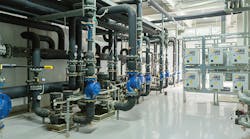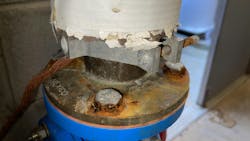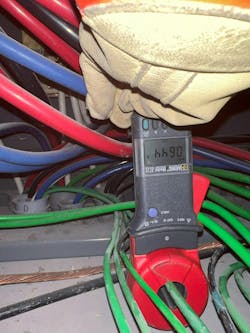What wastewater professionals need to know about grounding and bonding
Performance and reliability of critical loads and instrumentation
Wastewater treatment plant (WWTP) characteristics pump up the risks of developing power quality (PQ) based problems that impact the performance and life of critical loads & instrumentation.
These characteristics make WWTPs attract lightning and increase the susceptibility of electronic equipment to malfunction, damage and fail from external and internal sources of transients. Other physical characteristics promote corrosion, aging & weaking of the grounding and bonding (G/B) system that must protect the plant’s equipment, process, staff, and contractors.
This creates high risks of tripping the plant, damaging its electrical system and equipment, impacting wastewater treatment processes and encountering fines and undesired public exposure. Before describing how these characteristics can increase the risks, it is important to lump the characteristics together and discuss each one to help frame the need for immediate attention to the plant’s G/B system.
WWTP characteristics increase the power quality risks
WWTP’s must be designed to meet the requirements of the processes needed to treat wastewater 24 hours per day, seven days per week, and 365 days per year. Specific plant characteristics are required to meet the design and treatment requirements. These include:
- Large acre sites to locate buildings and reservoirs for each process;
- Proximity to rivers;
- Large ground level areas and tanks above and below ground level for water storage;
- Large volumes of reinforced concrete;
- 1000’s of feet of metal piping to transport water;
- 1000’s of feet of electrical piping to encase power and control wiring;
- Complex infrastructure of power and communications wiring interconnecting buildings and systems;
- Use of chemicals (some corrosive) and their effects on conductors and connections;
- High number of high amperage rotating electrical machines;
- Adoption of VFDs—small and large horsepower;
- Ground level substations and power feeds from transmission lines;
- High volume of electronic process control equipment with sensors sampling water conditions; and
- Increasing use of digital process control equipment.
How do these characteristics increase power quality risks?
Any characteristic or process (e.g., corrosion) of the plant’s G/B system that “weakens” it will increase the risks for PQ problems. By “weaking”, we mean the development of problems in the system that:
- slow (or reduce) ground currents down;
- provide an unacceptable path for them to flow; and
- allow unacceptable voltages to develop on the G/B system.
G/B systems naturally become weak as they age, through expansion and contraction with temperature, when vibrational energy (from large rotating machines) is generated around them and even when they must support high ground currents, which is what they are supposed to do. (High amperage ground currents can damage a G/B system if its conductors are not large enough.)
The need for multi-acre sites causes the lengths of power and communications cables as well as water piping between buildings to be longer. Long lengths of conductors buried in the ground increase their exposure to lightning currents that also travel underground. Although it is not preferred, metal pipes take a role in supporting ground currents. If a section or system of metal pipes with corroded joints must support transient currents, the slowdown or “backup” of a high-frequency ground current eager to reach Earth will cause voltage transients to develop across the plant.
Proximity to water bodies and conductive concrete
WWTPs must also be located on riverbanks. Lightning is more likely to strike infrastructures with large concrete surface areas close to large bodies of water. Concrete is conductive, especially when it is wet or damp. Lightning will strike concrete surfaces as well as metal objects. The storage of water and the large areas it requires increases the probability of a lightning strike.
Corrosion concerns for joints and connections
The use of corrosive chemicals introduces corrosion into the atmosphere surrounding the electrical system, its G/B components, and conductors as well as into power and communications connections. Corrosion occurs deep into the joints of the power and communications infrastructure where it cannot be detected or seen. G/B systems cannot exist without connections and joints which are vital to maintaining the low impedances necessary for proper G/B system performance.
Long lengths and large areas of steel (e.g., rebar, beams, etc.) and aluminum in WWTPs also increase lightning risks. High ampere loads require large conductors. Although higher capacity electrical systems require more complex G/B systems with larger equipment grounding conductors (EGCs), the connections and joints along their paths must be intact and ready to support ground currents of any frequency.
Variable frequency drives necessitaty high performance grounding and bonding
The application of VFDs in WWTPs is increasing rapidly. Plants have been using small VFDs (less than 25 hp) for years, but the recent development of high horsepower VFDs has made it possible for WWTPs to use them to control their large pump motors well into the 1000’s of horsepower. The increased use of VFDs in WWTPs necessitates higher performance G/B systems that have integral protection. VFDs are the most offensive electronic loads.
When they are controlling motors, they inject high-frequency currents into the G/B system. They also introduce transient currents into the phase conductors. Increasing the amount of high-frequency transient current that a G/B system must support increases the internal energy within the system. When this occurs, sudden changes in load, switching loads on and off, and the introduction of external high-frequency energy from lightning causes the G/B system to generate transient voltages that impact the performance of electronic equipment. G/B systems can be “sensitive” to the high-frequency energy they must support — almost like a “Catch 22” philosophy.
High voltage systems attract more lightning strikes
Because most WWTPs require megawatts of power and must start large horsepower loads, they are often powered directly from the utility transmission system. Although this improves some aspects of voltage performance, it increases the exposure of a plant to direct lightning strikes and overvoltage transients. The massive transmissions infrastructures that must support high voltage attract higher energy lightning.
A strike on a transmission system component several miles away can have a detrimental impact on a WWTP even if it is fed from a distribution substation powered by a different segment of the transmission system. Powering these plants from distribution systems increases the exposure to flashovers and equipment damage as well.
Many of the older WWTPs still use analog controls which can be damaged by voltage transients. While the shift towards digital controls vastly improves process control, it increases the risk of malfunction, damage, and failure of plant processes. Digital controls are much more susceptible to transients than analog controls. WWTPs that plan to upgrade to digital controls should have a detailed evaluation done on their G/B system followed by implementing G/B improvements and integrating internal protection into the G/B system.
What do typical grounding and bonding systems provide for WWTPs?
Typical G/B systems in WWTPs will generally support low-frequency and low amplitude ground currents well. They will provide an acceptable path for leakage currents.
However, when it comes to supporting high-frequency, high-energy ground currents, the G/B systems in most plants fail. Transient currents get routed through the wrong paths that frequently include electrical and electronic equipment.
When ground currents encounter high impedance conditions in the G/B system, voltage swells develop. These swells end up across some part of electrical and electronic equipment. These problems can be very difficult to diagnose without the trained eye, knowhow, and experience of an expert power quality engineer.
Typical G/B systems do not do a very good job of managing voltage transients and directing ground currents into the Earth as soon as possible.
Why do enhanced and protected grounding and bonding systems reduce risks?
Enhanced G/B systems with integral protection are always “looking” for transients to manage.
These systems provide low-impedance paths across their entire system and can provide these conditions for long periods of time. When transients are managed, electronic loads do not see these transients appear across their power and communications terminals.
When G/B systems direct large ground currents into the Earth through the shortest ground path, electrical and electronic equipment does not see voltage swells across their power terminals. Transient ground currents are managed regardless of their source — from lightning or the operation of loads inside the plant.
G/B systems must constantly provide transient management and low-impedance paths all across a plant. Lightning and transient voltages can occur anywhere on the plant site and even at multiple buildings/pieces of equipment simultaneously.
How do G/B problems affect the performance of surge protective devices (SPDs)?
Surge protective devices (SPDs) absorb transient energy and inject it into the G/B system. When the G/B system is weak, SPDs cannot perform as designed. On top of G/B problems, most SPDs installed in customer facilities are installed incorrectly.
Controlling impedance, whether it involves the G/B system or the SPD installation, is critical to SPD performance. If SPDs cannot perform as designed, they cannot provide coordination of absorbing surge energy.
When SPD performance is limited, the critical electrical and electronic equipment they are intended to protect is not adequately protected. Investing in high performance SPDs is a waste of money if the plant is plagued with G/B problems.
Detecting grounding and bonding problems
The proper way to detect G/B problems is not by observing malfunctioning, damaged or failed equipment. The proper way to detect G/B problems is to install high-performance permanent power quality monitoring at switchgear mains and at the AC input of critical and high power loads.
When properly installed and setup, power quality monitors can detect changes in the voltage and current behavior that will “alert” the trained power quality expert that something undesirable is occurring on the plant’s G/B system. Advanced monitors can also detect changes in the behavior of ground currents that can signal an expert that some part of a G/B system has been damaged or is malfunctioning. Monitoring can also alert someone to changes in the operation of high horsepower loads that could occur because of a G/B system problem.
Without permanent power quality monitoring, plant managers and engineers are left to detect G/B problems through observation of electrical and electronic equipment performance. When one observes the instant failure of an industrial power supply, a PLC or a VFD, this signals the existence of G/B problems in the plant. When equipment must be reset, reprogrammed or when data is lost, one can rest assured that G/B problems exist.
About the Author
Philip Keebler
Senior Power Quality Consulting Engineer
Keebler has worked for over 25 years in power systems/quality and its effects on electronic equipment, customer facility power systems & the utility power system. His experience allows him to understand the problems and apply the solutions from a systems perspective. The future for sensing on-coming problems before they impact society, and cause financial losses and catastrophic failures is bright and exciting. New research, faster instrumentation and more effective analysis tools applied at all power levels and points along the entire chain will institute the next paradigm shift in how power is generated, delivered and utilized. One cannot leave out the education process vital to teaching the incoming workforce what we've all learned and how to apply it to ensure this growing industry.




